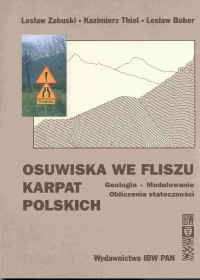
Polskiej Akademii Nauk



| ATTRIBUTE | VALUE |
|---|---|
| type | K |
| database id | 4598 |
| title | Osuwiska we fliszu Karpat polskich: geologia - modelowanie - obliczenia stateczności |
| authors | Zabuski L.1, Thiel K.1, Bober L. |
| affiliations | |
| year | 1999 |
| description | 171 s., 13 ark. |
| ISBN | 8385708332 |
| publisher | Wydawnictwo IBW PAN |
| place | Gdańsk |
| cover |  |
| keywords | Karpaty (góry) - geologia, osuwisko |
| signatures | II25053, II25054, II25055, II25056, II25057 |
| abstracts | The study contains the results of the comprehensive, interdisciplinary investigations of the landslide phenomena in Carpathian flysch. It is divided into two principal parts. The geological aspects of the slopes stability are described in the first part. It contains the description of the geological properties of the rock mass, especially important from the point of view of their influence on the slope stability. The problems connected with the systematisation of the mass movements and with the phenomena influencing the state of the slopes are analysed. The investigations history of the Carpathian landslides is shortly presented. The “landsliding” in flysch are next characterized (A. Kleczkowski defines this phenomenon as “repeated tendency to sliding, caused by the external conditions and connected with the internal causes”), with taking into account the geological structure of the massif. The “external conditions” act on the object from outside, whereas the “internal causes” are connected with geological structure of the rock mass composing the slope as well as with hydrogeological conditions and also with terrain morphology. The quantitative estimation of landslides appearance in different regions of Carpathians is proposed and geological classification of the slopes from the point of view of susceptibility to sliding is presented. Mechanical properties of the flysch rock mass are characterized, the mechanical models are discussed and results of the stability calculations are presented in the second part of the study. The geological properties described in the first part are considered as an input data to the models discussed here. It should be mentioned that the example slopes analysed in this part are partially fictitious. The extensive list of references is included at the end of the study. The appendices are also enclosed. They contain the example data regarding the material losses caused by the landslides in Carpathians, listings of the mechanical parameters of the flysch rocks and rock masses, description of the original distinct element method, which was used in the stability analysis of the slope composed of discontinuous rock mass. Praca zawiera rezultaty wszechstronnych, interdyscyplinarnych badań zjawisk osuwiskowych w Karpatach fliszowych. Dzieli się ona na dwie zasadnicze części. W pierwszej omówione są geologiczne aspekty stateczności zboczy. Dotyczy to właściwości geologicznych masywu fliszowego, szczególnie istotnych z punktu widzenia ich znaczenia dla warunków stateczności. W tej części omówiono zagadnienia związane z systematyzacją ruchów masowych i ze zjawiskami wpływającymi na stan zboczy. Krótko przedstawiono historię badań osuwisk karpackich, następnie - na tle budowy geologicznej obszaru Karpat fliszowych - scharakteryzowano w zarysie osuwiskowość we fliszu, która przez A. Kleczkowskiego określana jest jako "powtarzająca się skłonność do osuwania się, wywołana warunkami zewnętrznymi lub przyczynami wewnętrznymi". Warunki zewnętrzne oznaczają czynniki, oddziałujące na obiekt z zewnątrz, zaś przyczyny wewnętrzne wynikają z budowy geologicznej masywu, warunków hydrogeologicznych i morfologii terenu. W pracy zaproponowano ilościowe ujęcie występowania osuwisk w różnych rejonach Karpat a także geologiczną klasyfikację zboczy, traktującą podatność na utratę stateczności jako kryterium klasyfikacyjne. W drugiej części pracy scharakteryzowano właściwości mechaniczne ośrodka fliszowego, sformułowano jego modele mechaniczne oraz przedstawiono rezultaty analiz stateczności zboczy. Właściwości geologiczne stanowią tu informację o charakterze "danych wyjściowych" dla analiz. Część ta zawiera wyniki obliczeń stateczności i procesów deformacji zboczy przykładowych, oraz zboczy modelowych (fikcyjnych). Pracę kończy podsumowanie wyników oraz obszerne zestawienie literatury (częściowo są to materiały źródłowe), oddzielnie dla obydwu jej części. Ponadto zamieszczono cztery załączniki, zawierające przykładowe dane na temat szkód spowodowanych osuwiskami w Karpatach, zestawienia parametrów mechanicznych, które można wykorzystywać w analizach stateczności, oraz opis oryginalnej metody elementów oddzielnych, którą stosowano w badaniach stateczności dla nieciągłych modeli ośrodka. |
| attributes | [published] [reviewed] [scientific] [national coverage] |
| language | pl |
| points | 14 |